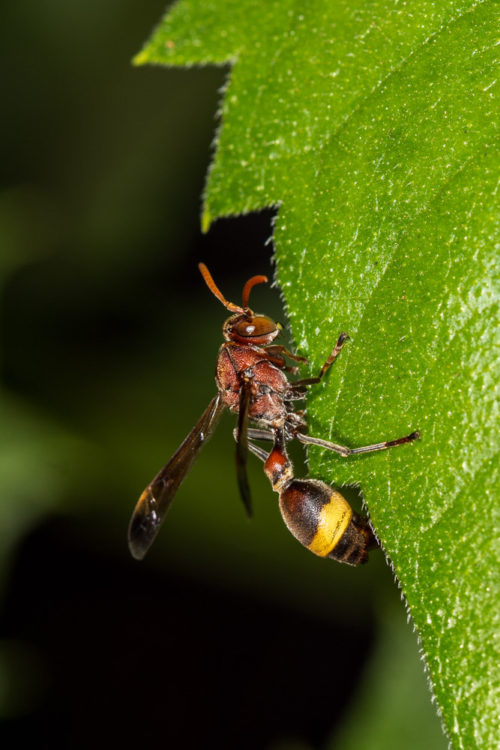
I found this Ropalidia species of paper wasp, resting on a leaf in my garden. I used my Canon EOS 5DS R fitted with Canon EF 100mm f/2.8L Macro IS USM, lit by Canon MT-24EX macro twin light flash with a DIY diffuser to capture this wasp.
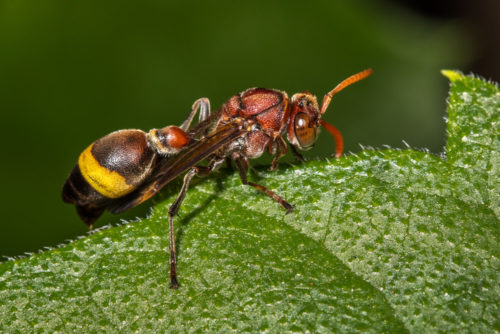
The social wasp genus Ropalidia, a primitively eusocial species occurring in the tropical climate of southern India and exhibiting a perennial, indeterminate colony founding cycle. As in many other species, new nests are initiated by one or a small number of female wasps. Ropalidia belongs to the family Vespidae, subfamily Polistinae, Tribe, Ropalidiini. The genus Ropalidia is unique because it contains both swarm founding species, meaning that new nests are founded by a large group of workers with a smaller number of inseminated females (egg-laying queens), as well as independent-founding, meaning that each nest is founded by a single queen.
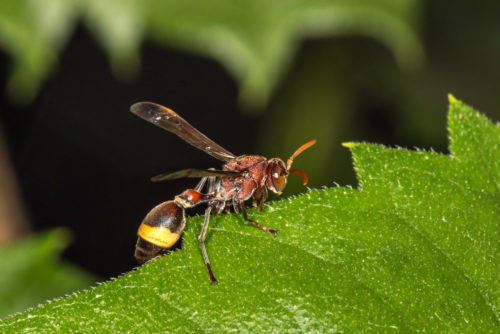
On the Indian subcontinent, there are 22 recognized species of the genus Ropalidia. Ropalidia are a dark reddish colour, with yellow spots on some joints and a yellow ring around the lower abdomen. Males differ from females by having a weaker mandible and lacking a stinger. The female workers are not morphologically different from the queen and are more distinguishable by behaviour. Females are hard to distinguish morphologically except for their level of ovary development, which generally increases with their age. Females are the default workers of Ropalidia, but they may also rise to queenship by taking over a resident queen, founding a new colony, or adopting an abandoned one.
Ropalidia nests are made of paper like material, which are produced by wasps masticating cellulose and mixing it with saliva. The nests are usually found in closed spaces with small openings in natural and man-made structures. In India, Ropalidia marginata has an aseasonal, indeterminate and perennial colony cycle, which means that nest initiation starts throughout the year, and nests are active throughout the year. Colonies are started more frequently from May to July when food is abundant and less frequently from December to February when temperatures are colder.
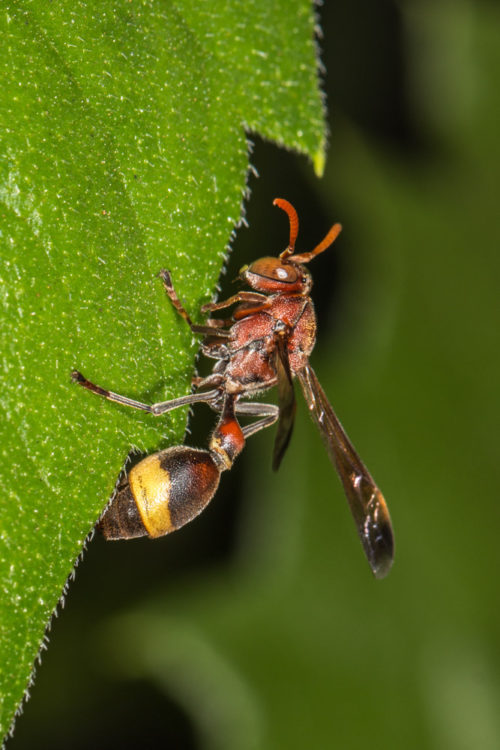
The distribution of Ropalidia extends as far west as Pakistan and as far east as New Guinea, Queensland, and some eastern Pacific islands. They are the most common social wasp in India.
Female workers forage to feed themselves and non-foragers, such as the queen, larvae, and males. They help to build the nest and care for the larvae. Workers may mate with males and remain inseminated even if they are never able to attain queenship and produce offspring.
When a queen is lost, a worker has the ability to take her place. The mechanism by which the next-in-line-queen is chosen is cryptic; neither age nor dominance accurately predicts the successor. The potential queen may or may not be inseminated or have developed ovaries. The only certainty is that after the queen is gone, the worker who is the potential queen will become very aggressive. The aggressiveness subsides after about two days. The potential queen seems to require this heightened aggression in order to boost her own development.
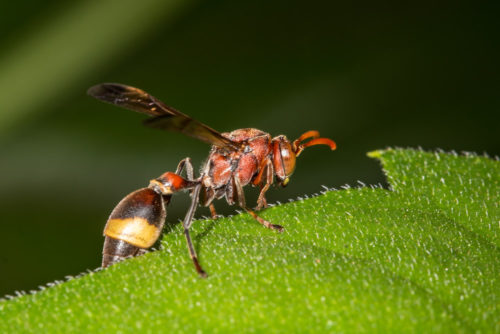
Males are produced less frequently and in less quantity than females are produced. After eclosion males remain on the nest for up to a week. Upon leaving, they live nomadically and mate with females of other nests and then die. Males do not assist in any of the colony maintenance activities while they reside in the nest. They are not well suited for foraging or defending the colony because of their weaker mandibles and lack of a stinger. They are totally dependent on female workers feeding them and are sometimes observed to cannibalize nest larvae.
Check its nesting behaviour of this Ropalidia wasp, in my earlier blog here.

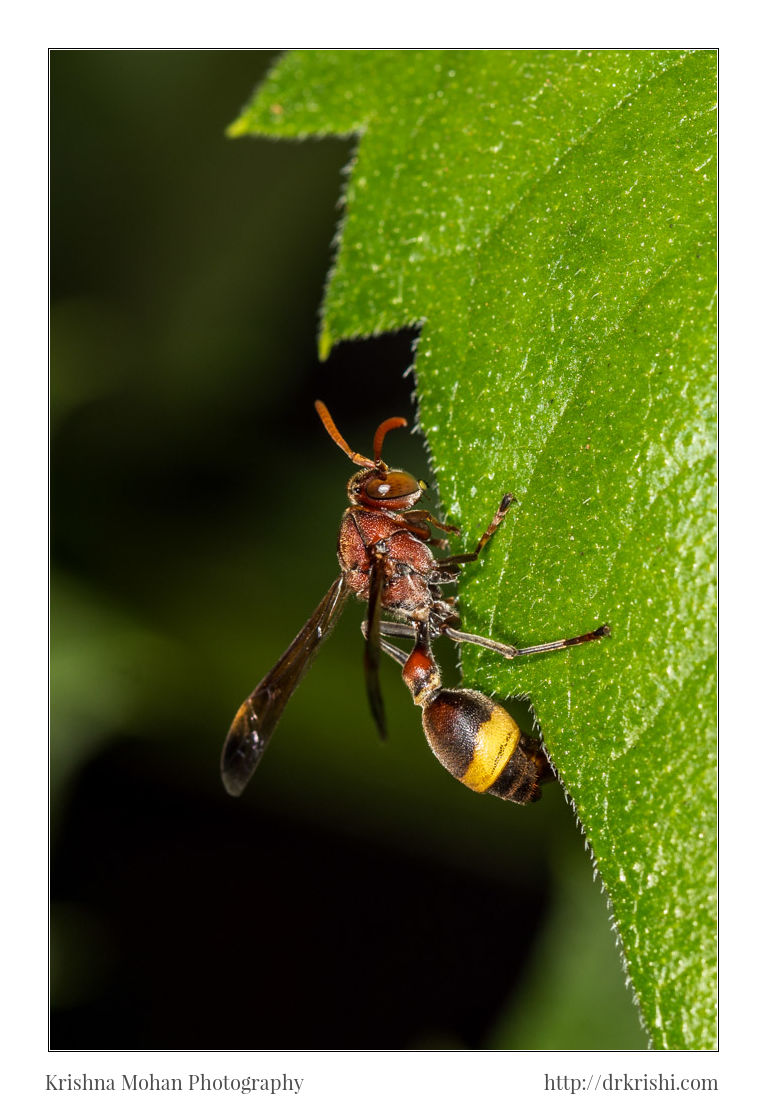
Sir I have clicked a pic of a wasp with stark similarity to ropalidia paper wasp, so are they found in North India too? Or is it some other species of paper wasp?
Without checking the features, it is very difficult to say a particular paper wasp is ropalidia paper wasp as there are many such paper wasps which look similar to ropalidia paper wasp. If you have a picture, do send it to me I can check and tell you. Thanks